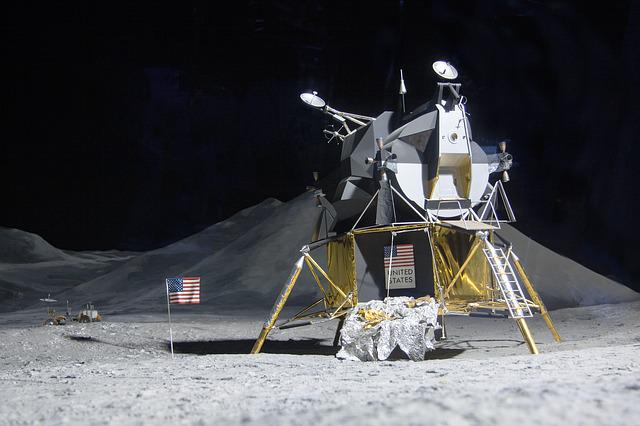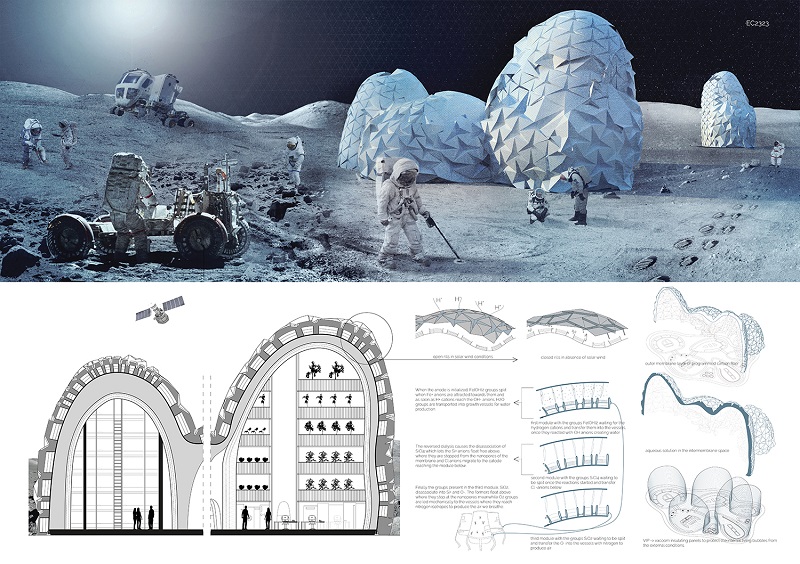Lunar and space architecture

|
| Moon Landing, Lunar Module Eagle. |
Contents |
[edit] Introduction
Space architecture refers to the practice of designing and building environments for the inhabitants of places beyond Earth, often including facilities for research and development. Much of the work to date has been for orbital space stations, lunar and martian exploration ships and surface bases for the world's space agencies.
There have also been a number of projects that simulate living conditions on other planets, with self-sustaining systems in enclosed biospheres which trainees and researchers can occupy for long periods to test our ability to exist in isolation. For more information see: Biosphere.
The UN General Assembly's resolution A/RES/65/271 in 7 April 2011, declared 12 April as the International Day of Human Space Flight: “to celebrate each year at the international level the beginning of the space era for mankind, reaffirming the important contribution of space science and technology in achieving sustainable development goals and increasing the well-being of States and peoples, as well as ensuring the realisation of their aspiration to maintain outer space for peaceful purposes.”
[edit] International committee
The Space Architecture Technical Committee (SATC) is one of the first formal organisations of space architects and industrial designers. It is an international committee of the American Institute of Aeronautics and Astronautics (AIAA) and organises sessions at international space conferences, advises on required skills, promotes and assists in research, and provides liaison between aerospace engineering, architecture and industrial design disciplines.
The SATC Charter states: "This charter defines Space Architecture broadly to encompass architectural design of living and working environments in space-related facilities, habitats, and vehicles. These environments include, but are not limited to: space vehicles, stations, habitats and lunar and planetary bases; and earth-based control, experiment, launch, logistics, payload, simulation and test facilities. Earth analogs to space applications may include Antarctic, airborne, desert, high altitude, underground, undersea environments and closed ecological systems. Designing these forms of architecture presents a particular challenge: to ensure and support safety, habitability, human reliability, and crew productivity in the context of extreme and unforgiving environments."
For more information see: http://spacearchitect.org/
[edit] International education
In terms of education, the Sasakawa International Centre for Space Architecture (SICSA) is an academic organisation within the University of Houston that offers a Master of Science in Space Architecture, working on design contracts with corporations and space agencies.
In Europe, The Vienna University of Technology and the International Space University (ISU) are involved in space architecture research: "ISU is the sole university worldwide devoted entirely to space education since 1987. Today, ISU is made up of a unique network around the world with a Central Campus in Strasbourg, with hubs in the USA and the Asia-Pacific region, and partnerships with leading space organisations worldwide. ISU is a 35-year success story with 5200 alumni shaping the international space ecosystem in 110 countries including astronauts and entrepreneurs along with current and former space industry and government leaders."
[edit] International conferences
There are a number of International conferences on the subject of space exploration, in particular two that include presentations covering themes of space architecture are:
- The International Conference on Environmental Systems meets annually to present sessions on human space flight and space human factors.
- International Conference on Space Architecture and Architectural Design also meets annually.
[edit] Moonotopia
In January 2017, the online architectural platform Eleven announced the winners of an ideas and design competition - Moontopia. Moontopia was an international challenge exploring design-led solutions for space architecture. Students, architects, designers, artists, academics and scientists from around the world were asked to propose visions for a self-sufficient lunar colony for living, working, researching and space tourism.
For more information see: Moonotopia.
[edit] Related articles on Designing Buildings
- Biome.
- Biosphere.
- Futurist architecture.
- Futuro House.
- High-tech architecture.
- Moontopia Lunar architecture.
[edit] External Links
- http://spacearchitect.org/resources/#publications
- https://www.un.org/en/observances/human-spaceflight-day
- http://spacearchitect.org/members/space-architecture-technical-committee/
- https://www.aiaa.org/membership/join-or-renew-your-aiaa-membership
- https://www.isunet.edu
- http://sicsa.egr.uh.edu/conferences
- https://www.ices.space
Featured articles and news
The UK's Modern Industrial Strategy: A 10 year plan
Previous consultation criticism, current key elements and general support with some persisting reservations.
Building Safety Regulator reforms
New roles, new staff and a new fast track service pave the way for a single construction regulator.
Architectural Technologist CPDs and Communications
CIAT CPD… and how you can do it!
Cooling centres and cool spaces
Managing extreme heat in cities by directing the public to places for heat stress relief and water sources.
Winter gardens: A brief history and warm variations
Extending the season with glass in different forms and terms.
Restoring Great Yarmouth's Winter Gardens
Transforming one of the least sustainable constructions imaginable.
Construction Skills Mission Board launch sector drive
Newly formed government and industry collaboration set strategy for recruiting an additional 100,000 construction workers a year.
New Architects Code comes into effect in September 2025
ARB Architects Code of Conduct and Practice available with ongoing consultation regarding guidance.
Welsh Skills Body (Medr) launches ambitious plan
The new skills body brings together funding and regulation of tertiary education and research for the devolved nation.
Paul Gandy FCIOB announced as next CIOB President
Former Tilbury Douglas CEO takes helm.
UK Infrastructure: A 10 Year Strategy. In brief with reactions
With the National Infrastructure and Service Transformation Authority (NISTA).
Ebenezer Howard: inventor of the garden city. Book review.
The Grenfell Tower fire, eight years on
A time to pause and reflect as Dubai tower block fire reported just before anniversary.
Airtightness Topic Guide BSRIA TG 27/2025
Explaining the basics of airtightness, what it is, why it's important, when it's required and how it's carried out.
Construction contract awards hit lowest point of 2025
Plummeting for second consecutive month, intensifying concerns for housing and infrastructure goals.
Understanding Mental Health in the Built Environment 2025
Examining the state of mental health in construction, shedding light on levels of stress, anxiety and depression.






















